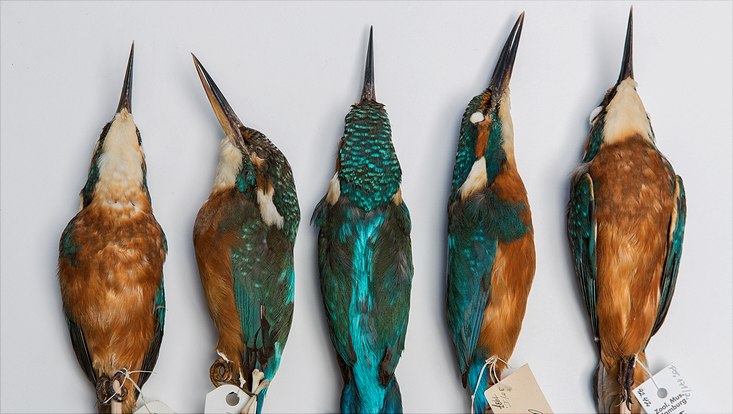
"The Gem of the Air"The kingfisher is treasure of the month February
4 February 2019

Photo: UHH/CeNak, Mentz
Many of the kingfishers are preserved in the form of such bellows. But also as skeleton and alcohol preparation kingfishers can be found in the collection.
Gray and inanimate, nature seems on your doorstep at this time of year. But once you go out and near clear waters with steep drop-offs and low-hanging vegetation, with a bit of luck you can see it flitting by - fast as lightning and shimmering blue. Not for nothing does the kingfisher (Alcedo atthis ispidae) bear the nickname "flying gem". It is our treasure of the month February.
There are many stories about the origin of its name. But it probably does not come from freezing waters, because the ice makes it difficult for the bird to find food. In Hamburg, the kingfisher can sometimes be found along the tributaries of the Alster, where it builds its nesting and breeding cavities in clayey steep slopes.
In addition to the 33 local kingfishers, most of which come from the Hamburg area, the collection also includes international representatives of the kingfisher from other genera and species. These come from Turkey, Sumatra, China, India, Java and Cameroon, among other places. This is because the range of animals from the kingfisher family extends far across the globe.
Kingfishers specialize in fish
The kingfisher family is divided into three subfamilies. One of them is the "actual kingfishers" (Alcidinae), which includes Alcedo atthis ispidae, the only one found in Central Europe. The other two are divided into "Tree Kingfishers" (Halcyoniae) and "Fisher Kingfishers" (Cerylinae). Species of the latter subfamilies are the only ones found in the Americas, but also in Asia and Africa, and all specialize in eating fish. The range of the "tree kingfishers", in turn, extends from Australia through South and Southeast Asia to Africa and includes mainly warm, but still very diverse habitats.
One of the most beautiful native bird species
With its shimmering cobalt blue plumage, the kingfisher is considered one of the most beautiful native bird species. Its population is currently classified as "not endangered" in Germany. However, it requires certain living conditions. It is therefore important to preserve its natural habitats or, if necessary, to create breeding opportunities and prevent water pollution. So that walkers can continue to see it scurry by.
